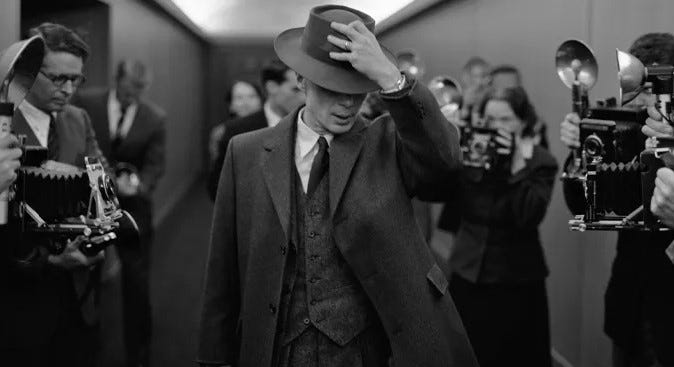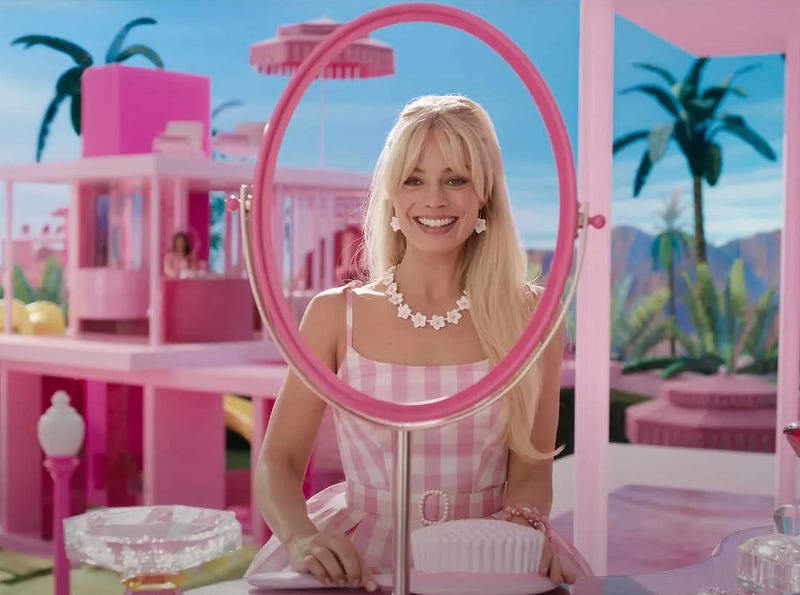
see Oppenheimer movie now for free
Oppenheimer
A Film by Christopher Nolan
Runtime: 180 minutes
In the breathtaking eighth installment of Twin Peaks: The Return, the series takes a fascinating detour from its main narrative to delve into the first test of the atomic bomb at White Plains, NM in 1945. This pivotal moment serves as an origin story for the Twin Peaks universe, featuring scenes of demonic figures infiltrating a picturesque desert town 11 years after the explosion. With Lynch’s enigmatic storytelling style, the true meaning of this connection between evil and the atomic age remains open to interpretation. However, given that Lynch was born just a year after the test, it’s hard to ignore the generational impact of growing up in a world with the ever-looming threat of nuclear devastation.
see Oppenheimer movie now for free
Christopher Nolan’s films may differ greatly from Lynch’s work, but in his biopic “Oppenheimer,” he explores similar themes of irreversibility. The movie focuses on J. Robert Oppenheimer, the “Father of the Atomic Bomb,” and treats the Trinity test as a turning point that forever altered the course of history, possibly leading it towards destruction. Known for playing with time in his films, Nolan employs the same technique in “Oppenheimer.” The story unfolds on two timelines, both anchored to significant hearings: one in 1954 where Oppenheimer (Cillian Murphy) faces a committee that might strip him of his security clearance due to his association with members of the Communist party, and another in 1958, shot in black-and-white, centered around the Senate confirmation hearing of Lewis Strauss (Robert Downey Jr.), a man with whom Oppenheimer had a complex and adversarial relationship.
“Oppenheimer” moves at a brisk pace, shifting freely through time as it navigates between the two narrative tracks. Nolan introduces a multitude of characters and seemingly unrelated incidents, inviting viewers to engage closely with the film. Multiple viewings or familiarity with the source material, Kai Bird and Martin J. Sherwin’s book “American Prometheus: The Triumph and Tragedy of J. Robert Oppenheimer,” enrich the viewing experience. Similar to “Dunkirk,” the film gradually reveals patterns, connections, and characters who play significant roles, all with Oppenheimer at the center, even when he is off-screen.
see Oppenheimer movie now for free
Cillian Murphy’s portrayal of Oppenheimer provides the film with its gravity and complexity. From the earliest scenes, Murphy embodies a man carrying an immense burden, aware that his scientific pursuits could have global consequences. His portrayal is haunting, with an unsettling physical resemblance to late-’70s David Bowie, along with a deliberate manner of speaking reminiscent of Peter Weller’s William S. Burroughs in “Naked Lunch.” Oppenheimer’s brilliance, his refusal to separate his educational pursuits from his leftist leanings, and the ensuing troubles are vividly brought to life by Murphy’s exceptional performance.
“Oppenheimer” functions as both a character study of a remarkably complex individual, whose greatest achievement becomes a source of torment, and a thrilling narrative of his journey through one of the most transformative events in human history. Nolan masterfully blends biography and thriller elements, intensified by Ludwig Göransson’s gripping score, creating an atmosphere of constant foreboding. The film skillfully portrays Oppenheimer’s interactions with a host of mid-century scientific minds, portrayed by a talented ensemble cast including Michael Angarano, Benny Safdie, Josh Hartnett, Jack Quaid, Rami Malek, and Olivia Thirlby. It also delves into his relationships with the women in his life, particularly psychiatrist Jean Tatlock (Florence Pugh) and his wife Kitty (Emily Blunt), showcasing their unwavering support and strength amidst the tumultuous circumstances.
see Oppenheimer movie now for free
Every scene in “Oppenheimer” exudes a sense of impending cataclysm, befitting a story that culminates in the creation of a world-altering weapon. Nolan’s skill at crafting grand cinematic experiences shines through, as he captures the awe-inspiring effort behind building the atomic bomb, including the establishment of the isolated community at Los Alamos. The film portrays the divisive nature of atomic weaponry even before the Trinity test, where some, like Oppenheimer, believed it could end all wars, while others saw it as an invitation for apocalypse. Ultimately, “Oppenheimer” paints a powerful portrait of a man who redirected history but found himself crushed by the world he helped shape. — Keith Phipps
see Oppenheimer movie now for free


Barbie
A Film by Greta Gerwig
Runtime: 114 minutes
In the age of IP dominance, directors with ambitious visions face a daunting challenge: How can they express their creativity while meeting the expectations of fans and adhering to brand standards? This dilemma is especially complex for Greta Gerwig’s “Barbie,” as the film revolves around an iconic doll that has had a profound impact on culture and shaped young girls’ perceptions of womanhood. Mere nods and references to the doll’s legacy are not enough; the movie must navigate delicate issues. Can it promote feminism while being associated with a toy corporation? How much can it question the doll’s historical reinforcement of beauty and achievement standards? And amidst all these considerations, can it still deliver an enjoyable and engaging cinematic experience?
Gerwig takes on this challenge, understanding that achieving perfection is impossible. Her “Barbie” cannot please everyone and must confront the contradictions that surround it. Yet, she embarks on a heroic effort, crafting a bright, funny, and subversive gem that fearlessly takes risks and asserts itself in the vast cultural landscape. The film portrays womanhood as a complex endeavor, requiring guile to define one’s terms. Instead of presenting stereotypical “strong” women often seen in blockbusters, Gerwig opts for complexity, creating a satisfyingly messy portrayal.
The film’s opening third resembles “The Truman Show” but with double the artifice. Stereotypical Barbie (Margot Robbie) resides in the utopian Barbieland, living harmoniously in her Dream House alongside an array of other Barbies and Kens, with one Ken (played by Ryan Gosling) particularly attached to her. Barbie’s idyllic life is interrupted by minor malfunctions at first, like “flat feet” and a simulated cold shower. However, deeper existential questions throw her into a profound crisis. “Weird Barbie” (Kate McKinnon), the town’s misfit, suggests that Barbie ventures into the real world to find the person responsible for making her sad. Accompanied by Ken, Barbie discovers the vast gulf between Barbieland and reality, while Ken revels in the possibility of bringing patriarchy into the mix. Simultaneously, the all-male executive team at Mattel, led by Will Farrell, attempts to manage the situation.
Gerwig envisions Barbieland as a visually vibrant, day-glo paradise where routines and perfection reign supreme in an imaginary world. The absurdity of these plastic dolls shifts to fish-out-of-water comedy when Barbie and Ken skate through Santa Barbara on rollerblades, confronting a topsy-turvy world where Barbie’s impact seems minimal. Gerwig and co-screenwriter Noah Baumbach are challenged by Barbie’s melancholy juxtaposed with Ken’s carefree enjoyment, with Gosling wholeheartedly embracing Ken’s love for a world that rewards his cocky ignorance and passion for horses. Yet, “Barbie” is like a massive stadium rock show where Gerwig holds the microphone: it may be bold and occasionally obvious in its delivery to the audience, but it remains an immensely powerful and entertaining spectacle. Gerwig remarkably weaves second and third-wave feminism into the film amidst dazzling musical numbers, whimsical gags, and the clever wit typical of Gerwig/Baumbach collaborations. The film thoughtfully addresses Barbie’s positive and negative influences, showcasing genuine integrity. Gerwig’s exploration of corporate messaging and industry sexism within Mattel’s board reveals her willingness to come to terms with Barbie’s lasting impact. The battle of the sexes continues in 2023, just as it did when Ruth Handler created the doll in 1959, and Gerwig boldly asserts that the issues are far from resolved. — Scott Tobias
